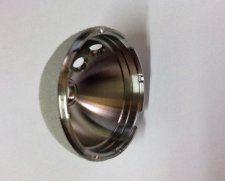
Categorised under:
Orthopaedics
>
Hip
>
Acetabular components - uncemented
The Trident Acetabular System comprises an uncemented shell and a variety of liner options, (including ceramic liners, which have been problematic, see product description) and constrained liners if there is a substantial dislocation risk. My experience with the Trident shell has been in pairing it with a cemented Exeter or an uncemented Accolade stem.
The Trident Acetabular System comprises an uncemented shell and a variety of liner options, (including ceramic liners, which have been problematic, see product description) and constrained liners if there is a substantial dislocation risk. My experience with the Trident shell has been in pairing it with a cemented Exeter or an uncemented Accolade stem.
The versions available include the hemispherical and the peripheral self locking (PSL) device, which has an expanded equatorial diameter compared with the depth of the shell. Anecdotally, the PSL device is technically a little more difficult to implant – there seemed to be a greater need for screws to gain good fixation when used in our centre. In addition, the rim of the acetabulum needs to be intact for the shell to be very stable. We therefore use the hemispherical option routinely.
The outside of the shell is hydroxyapatite coated, and looks a little smoother than some other devices (see images). Both cluster hole and no-hole options are available. When reaming for an uncemented shell, I tend not to ream directly medially with a 40mm reamer as one might with a cemented socket with a large medial osteophyte. Instead, the concept is to start with a relatively large reamer, close to the size of the acetabulum and start reaming in the orientation of the cup. The intention is to create an acetabulum which is as spherical as possible, rather than ovoid. Similarly, I tend to ream until the articular cartilage has gone and there is at least pinpoint bleeding from the bone. Certainly this is different from cemented sockets when the intention is to start to open up the cancellous bone structure for cement penetration.
I prefer to trial before the final reaming, when I am getting close to the final shell size. The first trial tends to be 2mm over the last reamer, a size difference which works for softer bone, slightly overreamed bone or large acetabulae. The cutaway design of the trial shells allow excellent visualization of the acetabulum. Often, a further gentle reaming 1mm below the trial size is needed to get the trial to sit down on the acetabular floor. On occasion, in hard bone, an even gentler reaming with a reamer of the same size as the shell is needed. When trialling, one is aiming for a trial that is solid enough to move the patient when it is impacted. If I don’t get this stability, I would go for a cluster hole shell and use 2 screws.
The introducer screws into the shell and this works well – I have had no problems with the shell becoming mobile on the introducer. The shell has a full-thickness hole for the introducer, so even in the solid back versions, there is a need to insert a plug after removing the introducer if you want a solid shell. As this cap comes as standard with the solid back shell, there is no cost implication. The benefit of this is that you can remove the introducer and put a probe into the hole if you want to assess whether the shell is adequately seated.
I routinely use a 28mm X3 liner with a 10 degree augment for the back of the acetabulum, as I use a posterior approach. Other variants are available, and some of the images show a 32mm liner. The locking mechanism allows one to change the rotation, as long as the lugs of the liner fit the shell. Having used the Trilogy socket in the past, I missed the locking ring of the latter as it gave a good indication that the liner is seated. However, I have had no problems with seating of the polyethylene liner in the Trident shell. I haven’t had to remove one so far, so I can’t comment how easy (or difficult!) this is.
I have been generally very happy with this socket, and results have been good, with no failures in a small personal series. Published results from the UK National Joint Registry have also been satisfactory.

Did you know you can Register for FREE with this website?
Registration gives you full access to all of the features of WhichMedicalDevice. Find out more ...
WhichMedicalDevice is a FREE resource created by clinicians for clinicians.
Registration is free and gives you unlimited access to all of the content and features of this website.
Find out more...Registration is free and gives you unlimited access to all of the content and features of Which Medical Device. Find out more...
Which Medical Device is a community of clinicians sharing knowledge and experience of the devices and procedures we use on a daily basis. We ask that our members register with us so that we can maintain the unbiased and independent nature of our content. Registration is quick and free.
We do not make your details available to any third parties nor do we send unsolicited emails to our members. You can read our Privacy Policy here.